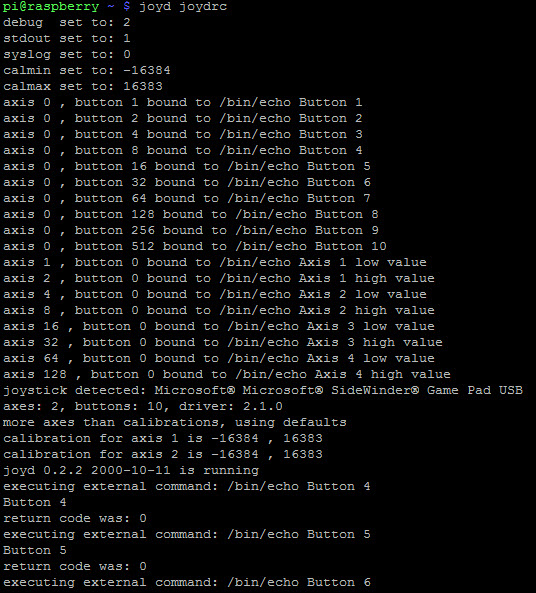You are here
Gamepad To Run Commands on Pi
I want to build a kiosk style system on a Raspberry Pi where you can press a button a command gets executed like omxplayer to play a video, qiv to display an image, or even display a web page.
I could tie in to the GPIO ports but I was thinking a faster way may be to use a gamepad and its buttons.
I looked around and most of my web search efforts pointed to gaming on the Raspberry Pi, which makes sense, but that is not what I wanted. But I did come accross an older than a decade daemon called joyd
In this doc I will go through installing it and configuring it on a Raspberry Pi.
The build I did was on a stock raspberrian image (2013-02-09-wheezy-raspbian.img) with nothing else added, not even patched.
I did this mostly using the pi account where the only time I had to sudo was for the make install command.
First download the files
wget http://www.cgarbs.de/stuff/joyd-0.2.2.tar.gz wget http://www.cgarbs.de/stuff/joyd-fix-build.patch
tar xvf joyd-0.2.2.tar.gz
cd joyd-0.2.2/
patch -p1 < ../joyd-fix-build.patch./configure make sudo make install
- look in /dev/input for a js0 device
- Run dmesg after plugging it in to see if your gamepad is recognized
- or run lsusb to see if it is detected

Now to test out joyd, copy a sample joydrc config file over to your home directory
cd cp /usr/local/doc/joyd/joydrc .
Modify the file,
# # sample configuration file for joyd # # This helps you to find out the numbers of your buttons and axes. # Use ctrl-c to quit joyd. # [general] # Some general settings device /dev/input/js0 daemon 0 debug 2 stdout 1 syslog 0 calmin -16384 calmax 16383 [actions] # These are the buttons that can be pressed 0 1 /bin/echo Button 1 0 2 /bin/echo Button 2 0 4 /bin/echo Button 3 0 8 /bin/echo Button 4 0 16 /bin/echo Button 5 0 32 /bin/echo Button 6 0 64 /bin/echo Button 7 0 128 /bin/echo Button 8 0 256 /bin/echo Button 9 0 512 /bin/echo Button 10 # These are the axes 1 0 /bin/echo Axis 1 low value 2 0 /bin/echo Axis 1 high value 4 0 /bin/echo Axis 2 low value 8 0 /bin/echo Axis 2 high value 16 0 /bin/echo Axis 3 low value 32 0 /bin/echo Axis 3 high value 64 0 /bin/echo Axis 4 low value 128 0 /bin/echo Axis 4 high value
joyd joydrc

- I tried several gamepad devices, most worked, I had one not work, a Saitek but I think it was broken.
- You will get better results with a powered USB hub
- The normal pi user should be part of the input group which has permissions to the /dev/inputjs0 device.
Theme by Danetsoft and Danang Probo Sayekti inspired by Maksimer
